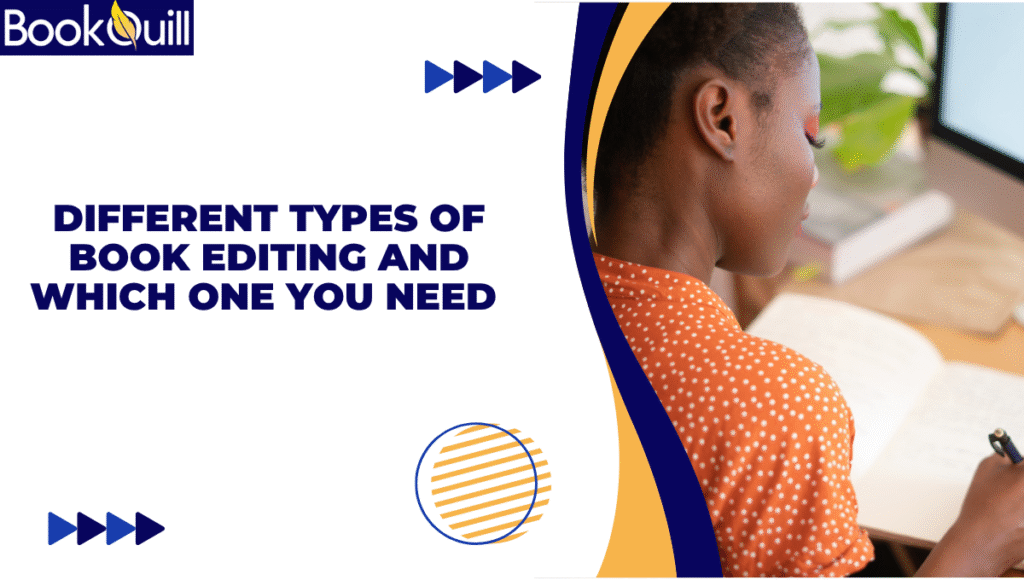
What if I told you there’s one thing just as important as writing a book itself? Would you believe it? Well, believe it or not, that thing is book editing. Most amateur authors fail to recognize its importance. Editing decides whether your book will make it—or shatter into pieces.
There are multiple types of editing, and quite frankly, if you miss the right one, your book could stumble where it should soar. Choose the right one, and suddenly your words hit exactly how they’re supposed to.
This blog is all about that—so sit tight and learn what you can, if you really want to succeed in this market.
What Is Book Editing and Why It Matters
This is as simple as it gets: book editing is the process of taking your raw manuscript and transforming it into something readers actually want to read. It’s the bridge between a good idea and a great book. Without it, even the strongest stories can come across as sloppy, uneven, or downright unreadable. Editing is what turns your draft from just words on a page into a polished piece that carries weight. Now, not every author will need every single type of editing—but knowing the difference between them is the key. Miss the right one, and you’ll hold your book back from reaching its full potential.
The Main Types of Book Editing
Developmental Editing (Big-Picture Surgery)
This is where the heavy work gets done. In this type of book editing, the editor digs into the core of your story—structure, pacing, character arcs, and whether the plot actually makes sense. If your draft feels clunky, has holes big enough to drive a truck through, or you just know something is “off,” this is the edit you need. It’s like surgery for your book. The good news? There are affordable book editing services out there that can help you figure it all out without leaving you broke—so you can put out the best possible product before publishing.
Line Editing (Sharpening the Voice)
Once your structure and plot are locked in, this type of book editing steps in to smooth the ride and clear out the bumps. Line editing is all about flow, clarity, and style—making sure every sentence pulls its weight and your voice comes through sharp and consistent. If your writing feels flat, repetitive, or awkward, this is the edit that breathes life into it. It’s not about hunting mistakes; it’s about making your prose sing.
Copyediting (The Precision Pass)
This is where the microscope comes out. Copyediting handles grammar, spelling, word usage, punctuation, and overall consistency. It’s the detail-oriented pass that makes your manuscript look professional. My advice? Get help from a top book editing service—because here’s the truth: you’ll always be biased about your own work. A second pair of eyes will catch things you’ll never see, and that can make a bigger difference than you think.
Proofreading (Final Safety Net)
This is the final line of defense in your book editing journey. Proofreading catches the little slip-ups—typos, spacing errors, formatting glitches—that manage to sneak past every other stage. It won’t touch your story or your style, but it will save you from embarrassment. Think of it as the final polish that makes your book truly print-ready.
How to Know Which Editing You Need
Ask Yourself the Right Questions
The type of book editing you need depends on where your manuscript stands. Is your draft rough, full of big gaps and shaky pacing? Then developmental editing is your best bet. Do readers say the story is good but the writing doesn’t flow? That’s a job for line editing. Are you confident in the story but want it cleaned up for grammar and consistency? Copyediting is your stage. And if everything feels ready but you just want to make sure no typos survive, go for proofreading.
Budget and Market Reality
Here’s the hard truth—book editing isn’t cheap, and trying to do it all at once might not be realistic. But skipping the wrong stage will cost you more in the long run. A sloppy structure means rewrites later. Publishing without copyediting will damage your credibility. The smart move is to prioritize: start with developmental editing if your draft is raw, line editing if your story works but needs polish, and proofreading at the end no matter what. If budget is tight, look into affordable writing editing services that still deliver quality—you don’t have to empty your wallet to make your book shine. Consider it an investment, because in this market, readers won’t forgive careless mistakes.
Common Mistakes Authors Make
The biggest mistake most authors make? Skipping editing altogether, thinking their draft is “good enough.” Next up—confusing copyediting with proofreading, like they’re the same thing. They’re not. Then there’s the myth that beta readers count as professional editors. Spoiler alert: they don’t. And some writers try to make one type of edit cover everything, which is like fixing a blown engine with duct tape. Each stage of book editing has its job, and ignoring that will only drag your book down.
Final Thoughts
Editing isn’t the enemy—it’s the lifeline of your book. Skipping it, or choosing the wrong type, is like sending your story into battle unarmed. Each book editing stage has its role: developmental reshapes the story, line editing sharpens the voice, copyediting cleans up the details, and proofreading ensures no mistake survives. Think of editing as an investment, not a cost. If you’re serious about publishing, editing is the bridge between your raw words and a book readers actually trust—and love.
Everything Authors Ask About Editing
- Do I need all four types of book editing?
Not always. It depends on your manuscript’s stage. A rough draft may need developmental editing, while a polished draft might only need copyediting and proofreading. - What’s the difference between line editing and copyediting?
Line editing focuses on flow, clarity, and style—making your writing sing. Copyediting focuses on grammar, punctuation, and consistency—making your writing professional. - Can I skip proofreading if I’ve already done copyediting?
No. Proofreading is your last defense against typos and formatting errors. Even the best manuscripts can hide small mistakes. - Are beta readers a substitute for professional editing?
No. Beta readers can give useful feedback, but they’re not trained editors. Professional editing ensures your book meets publishing standards. - How do I know which type of editing I need?
Ask yourself where your draft struggles:
- Story structure/pacing → Developmental Editing
- Flow and style → Line Editing
- Grammar/consistency → Copyediting
- Final polish → Proofreading





